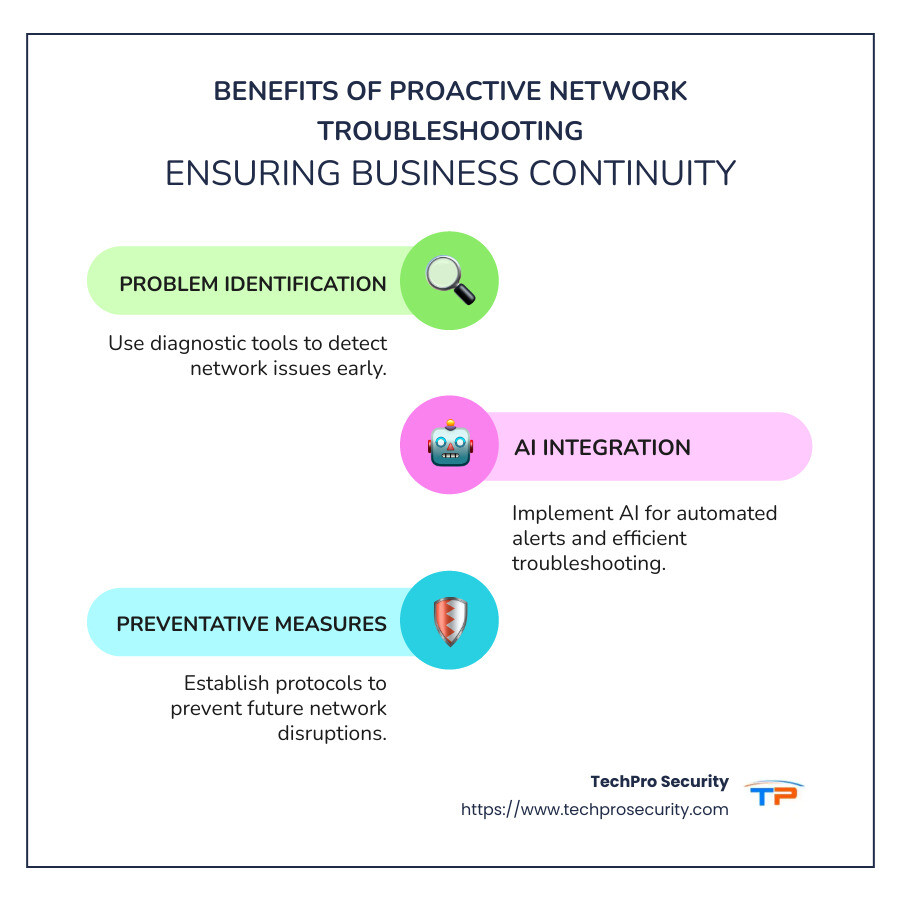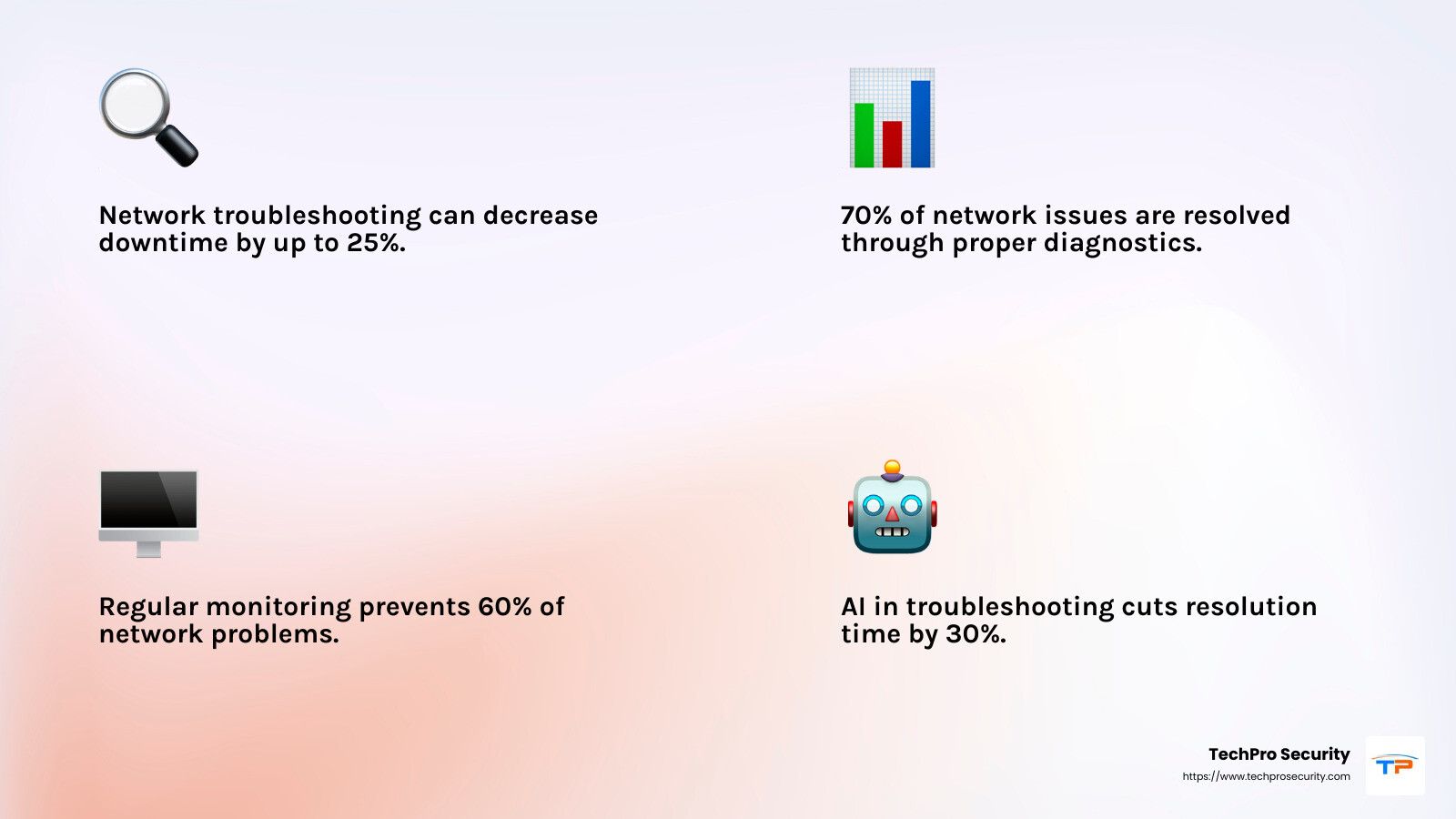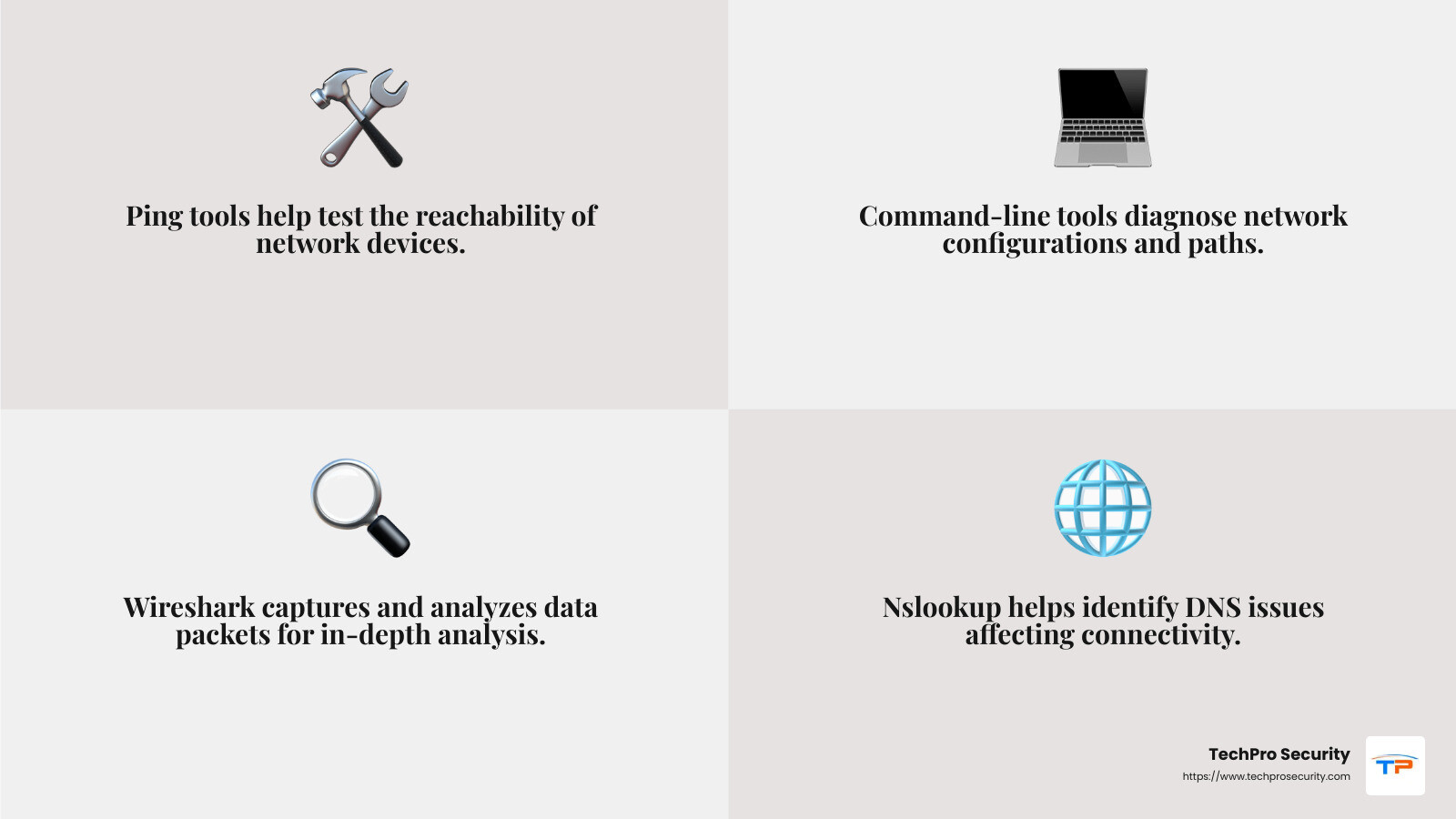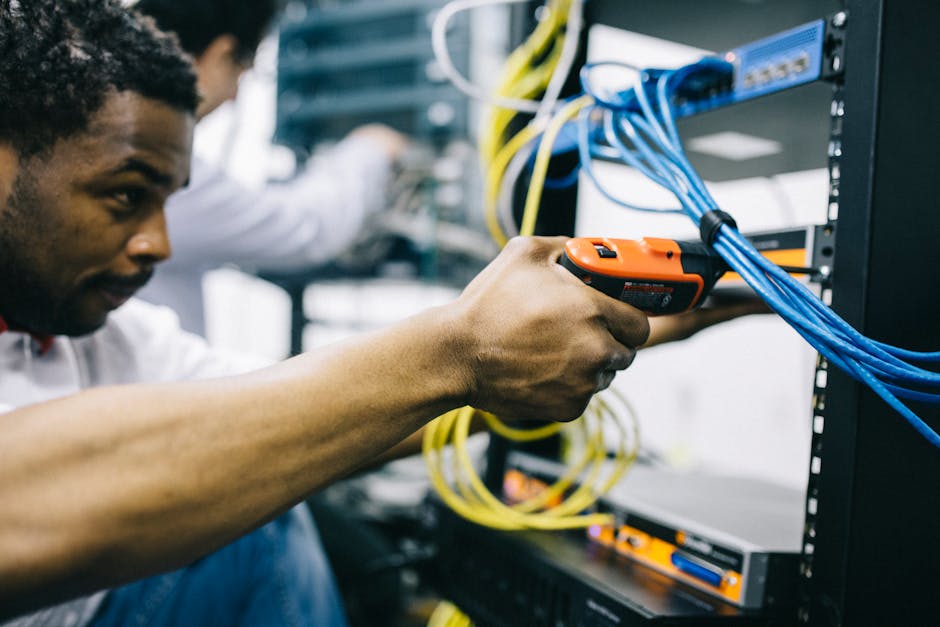Network troubleshooting services: Top 5 Proven Solutions
Network troubleshooting services are crucial for keeping business operations running smoothly and minimizing downtime. In today’s digital world, networks handle countless mission-critical tasks. Without rapid and effective troubleshooting, unforeseen issues can lead to costly interruptions, reduced productivity, and even potentially damaging data breaches.
Here’s a quick look at what network troubleshooting services provide:
- Identifying connectivity and performance issues
- Ensuring security by safeguarding against data breaches and malware attacks
- Utilizing AI and automation to streamline problem-solving
- Leveraging network monitoring systems for proactive alerts and status updates
With effective network troubleshooting, organizations can prevent disruptions before they impact your business. This isn’t just about fixing Wi-Fi connections; it’s a comprehensive approach involving various tiers of troubleshooting to tackle problems at their core.
I’m Brad Besner, and I bring a wealth of experience in security and network troubleshooting services. As the founder of TechPro Security, I’ve been committed to integrating cutting-edge technologies to improve and protect networks, ensuring business continuity and resilience.

Understanding Network Troubleshooting
Network troubleshooting is the process of identifying, diagnosing, and resolving network issues to ensure seamless connectivity and performance. This is essential for maintaining business operations without interruptions.
1. The Troubleshooting Process
The troubleshooting process is a structured approach that helps in pinpointing the root cause of network problems. It involves several steps:
- Identifying the Problem: Start by gathering information about the issue. Is it a connectivity problem, slow speeds, or something else?
- Diagnosing the Issue: Use diagnostic tools to analyze network traffic, check configurations, and evaluate performance metrics.
- Testing and Verification: Implement solutions and test to verify if the problem is resolved. This might involve rerouting traffic, adjusting configurations, or updating software.
2. Key Network Components
Understanding the components of a network helps in effective troubleshooting. Here are the primary elements:
- Routers and Switches: Direct traffic and manage data flow within the network.
- Cables and Connectors: Ensure physical connectivity between devices.
- Network Devices: Includes servers, computers, and other connected devices.
- Network Management Systems (NMS): Monitor network performance and provide alerts for potential issues.
3. Problem-Solving Techniques
Problem-solving in network troubleshooting involves both reactive and proactive approaches:
-
Reactive Troubleshooting: Address issues as they arise. This includes tasks like resetting devices, checking connections, and resolving IP conflicts.
-
Proactive Troubleshooting: Involves regular monitoring and maintenance to prevent issues before they occur. Utilizing AI and machine learning can improve this process, allowing for quicker identification and resolution of complex problems.

By understanding these components and processes, businesses can ensure their networks run smoothly and efficiently. This proactive approach minimizes downtime and maximizes productivity, keeping operations resilient and secure.
Essential Network Troubleshooting Services
When it comes to network troubleshooting services, having a reliable partner like TechPro Security can make all the difference. Here’s a breakdown of the essential services offered that ensure your network remains robust and uninterrupted:
Diagnostics and Analysis
1. Comprehensive Network Assessment
TechPro’s expert technicians start with a thorough evaluation of your network. This involves examining hardware, software, and configuration settings to identify any underlying issues. Advanced diagnostic tools are used to leave no stone unturned, ensuring that the root causes of network problems are accurately identified.
2. Traffic and Performance Analysis
Analyzing network traffic is crucial for identifying congestion points and sources of latency. TechPro benchmarks your network’s performance against industry standards to pinpoint areas for improvement. This proactive approach helps in maintaining optimal network functionality.
Problem Resolution
1. Immediate Issue Mitigation
Once issues are identified, TechPro takes swift action to resolve them. Prioritizing critical issues ensures minimal disruption to your operations. Whether it’s adjusting configurations or rerouting traffic, the focus is on restoring functionality promptly.
2. Configuration Adjustments and Documentation
Necessary adjustments to hardware and software configurations are made to optimize performance. Detailed documentation of the troubleshooting process, findings, and actions taken is provided for your reference, ensuring transparency and clear communication.
Preventive Measures
1. Network Security Improvements
To prevent future network problems, TechPro assesses your network’s security posture and recommends improvements. This includes protecting against cyber threats and ensuring data integrity.
2. Regular Maintenance Plans
Customized maintenance plans are designed to keep your network in optimal condition. Regular check-ups and updates help in preventing potential problems before they occur.
3. Staff Training
Empowering your IT staff with the skills needed to identify and address minor network issues is part of TechPro’s preventive strategy. Training sessions are offered to ensure your team is well-equipped to handle basic troubleshooting tasks.
With these essential services, TechPro Security ensures your network remains resilient and efficient, minimizing downtime and maximizing productivity. Next, we’ll explore some common network issues and their solutions, helping you address problems that might arise in everyday operations.
Common Network Issues and Solutions
Even with a solid network setup, problems can arise. Here are some common network issues and straightforward solutions.
Slow Speeds
Why It Happens:
Slow internet speeds can be frustrating, especially when you need things done quickly. This can be due to network congestion, outdated hardware, or even interference from other devices.
Quick Fixes:
- Check for congestion: Use tools to analyze network traffic. If there’s a bottleneck, you may need to upgrade your network capacity.
- Update your hardware: Ensure your modem and router are up to date. Older models might not support higher speeds.
- Reduce interference: Keep your router away from other electronic devices and large metal objects. These can interfere with the signal.
Weak Wi-Fi
Why It Happens:
A weak Wi-Fi signal can make it difficult to stay connected. This issue often arises in larger homes or buildings where the signal has to travel through walls and floors.
Quick Fixes:
- Reposition your router: Place your router in a central location. Avoid corners and enclosed spaces.
- Use a Wi-Fi extender: If certain areas still have weak signals, a Wi-Fi range extender can help boost the signal.
- Switch channels: Sometimes, changing your Wi-Fi channel can reduce interference from other networks.
Connectivity Problems
Why It Happens:
Connectivity issues can prevent devices from accessing the network. This might be due to incorrect settings or a malfunctioning device.
Quick Fixes:
- Restart your devices: Power cycle your modem, router, and the affected device. This can resolve many temporary issues.
- Check your cables: Ensure all cables are properly connected. A loose cable can disrupt your connection.
- Review network settings: Verify that your device settings match your network’s configuration. Incorrect settings can block access.
In tackling these common issues, TechPro Security’s network troubleshooting services can provide expert help. Their comprehensive approach ensures that your network remains reliable and efficient, reducing the risk of downtime.
Next, we’ll dig into the tools and techniques used for effective network troubleshooting, giving you the knowledge to handle more complex scenarios.
Tools and Techniques for Network Troubleshooting
When it comes to resolving network issues, having the right tools and techniques can make all the difference. Let’s explore some essential utilities that can help you troubleshoot effectively.
Ping Tools
What They Do:
Ping tools are used to test the reachability of a device on a network. They send packets to a specific IP address and measure the time it takes to receive a response. This helps identify if a device is online and how fast the connection is.
How to Use Them:
– Basic Ping: Open your command prompt and type ping [IP address]. This will give you a basic idea of the connectivity status.
– Continuous Ping: Use ping -t [IP address] to continuously ping and monitor changes in response time.
Command-Line Tools
Command-line tools are powerful for diagnosing network issues. Here are a few you should know:
- ipconfig/ifconfig: Displays network configuration details. Use it to check your IP address and network settings.
- tracert/traceroute: Shows the path data takes to reach a destination. This helps identify where delays or failures occur.
- netstat: Lists active connections and listening ports. It’s useful for identifying unauthorized connections.
Diagnostic Tools
Advanced diagnostic tools provide deeper insights into network performance and issues:
- Wireshark: An open-source packet analyzer that captures and displays data packets. It’s ideal for in-depth analysis.
- tcpdump: A command-line packet analyzer for capturing and analyzing network traffic in real time.
- nslookup/dig: Used for querying DNS servers to obtain domain name or IP address mapping. This helps identify DNS issues.
These tools and techniques are part of TechPro Security’s comprehensive approach to network troubleshooting services. By employing these utilities, they ensure network issues are identified and resolved swiftly, minimizing downtime and maintaining smooth operations.

Next, we’ll address some frequently asked questions about network troubleshooting services, providing clarity on common concerns and processes.
Frequently Asked Questions about Network Troubleshooting Services
What is network troubleshooting?
Network troubleshooting is a logical process used to identify and resolve issues affecting network performance. It involves a series of steps to ensure smooth operations and connectivity. Network engineers are often at the forefront of this process, using their expertise to diagnose problems and implement solutions. The goal is to maintain optimal network performance, minimize downtime, and prevent future issues.
How can I troubleshoot my network?
Troubleshooting your network can be straightforward if you follow these basic steps:
-
Use Ping Tools:
Start by using ping tools to check device reachability. This involves sending packets to a specific IP address to see if the device responds. If there’s no response, the device might be offline or experiencing connectivity issues. -
Check ICMP (Internet Control Message Protocol):
Ensure that ICMP is enabled on your network devices. This protocol is crucial for sending error messages and operational information, like when a service is unavailable or a device is unreachable. -
Restart Devices:
Sometimes, simply restarting your modem, router, or affected device can resolve temporary glitches. This can clear any minor errors and re-establish a fresh connection. -
Switch Connections:
If you’re experiencing issues with a wireless connection, try switching to a wired connection using an Ethernet cable. This eliminates potential Wi-Fi interference and can confirm if the problem is with the wireless network. -
Use the Settings App:
Access the settings app on your device to check network configurations. Ensure that all settings are correct and match your network requirements.
What are the steps in network troubleshooting?
To effectively troubleshoot network issues, follow these structured steps:
-
Identify the Problem:
Gather information about the issue. Is it affecting a specific device or the entire network? What are the symptoms? -
Isolate the Cause:
Determine if the problem is hardware-related (e.g., faulty cables) or software-related (e.g., incorrect settings). -
Test Connectivity:
Use ping tools and ICMP to test device reachability. This helps confirm which devices or connections are affected. -
Implement Solutions:
Based on your findings, apply the appropriate fixes. This could involve restarting devices, adjusting settings, or replacing faulty hardware. -
Monitor Results:
After implementing changes, monitor the network to ensure the issue is resolved and no new problems arise.
By following these steps, you can effectively address and resolve common network issues. TechPro Security’s network troubleshooting services are designed to assist with these processes, ensuring your network remains efficient and reliable.
Next, we’ll dive into common network issues and solutions, shedding light on how to tackle frequent connectivity challenges.
Conclusion
At TechPro Security, we understand the critical role that a reliable network plays in ensuring business continuity and success. Our network troubleshooting services are designed to improve network resilience, allowing your business to operate smoothly and efficiently.
Network resilience is about more than just fixing problems when they arise; it’s about preparing your network to withstand potential issues before they can impact your operations. By employing proactive measures, such as regular maintenance and performance benchmarking, we help ensure your network remains robust against unexpected disruptions.
Business continuity is our ultimate goal. We know that downtime can be costly, both in terms of lost productivity and potential revenue. That’s why our team of skilled professionals is dedicated to providing rapid response and effective solutions to keep your network running at its best. Whether it’s through immediate issue mitigation or long-term preventive strategies, we work tirelessly to safeguard your business against network failures.
In conclusion, trusting TechPro Security with your network management needs means investing in a partner committed to your business’s success. Our expertise, combined with our commitment to client-centric service, ensures that your network is not only operational but optimized for future growth.
For more information on how we can help improve your network’s performance and resilience, visit our Network Management Services page.
With TechPro Security by your side, you can focus on what matters most—growing your business—while we take care of keeping your network secure and efficient.

